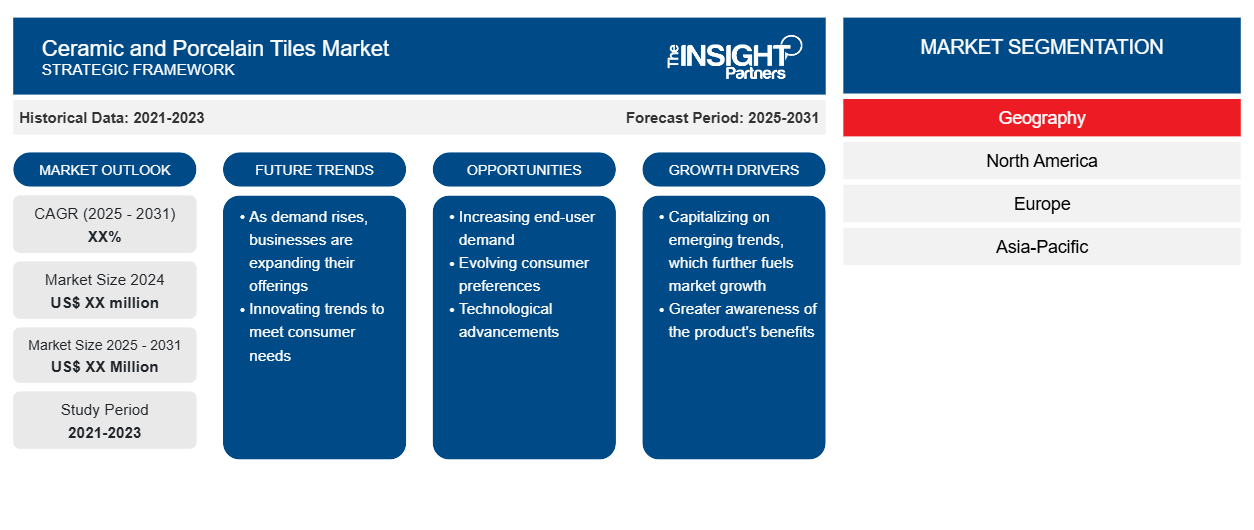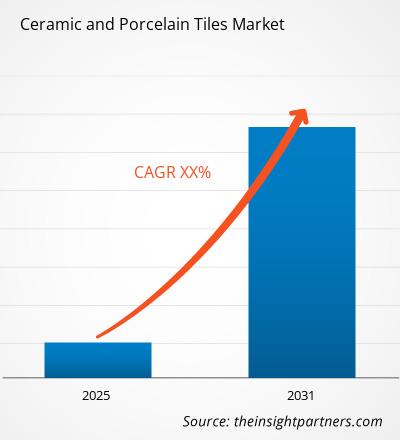ANALISI DI MERCATO
Il mercato della ceramica e della porcellana si riferisce al settore coinvolto nell'industria globale delle costruzioni e dei materiali da costruzione. Le piastrelle in ceramica e porcellana sono utilizzate in varie applicazioni come pavimenti, rivestimenti murali, piani di lavoro, ecc. Le piastrelle in ceramica sono composte da una miscela di minerali, acqua e argilla, che vengono poi modellate e cotte ad alte temperature. Le piastrelle in porcellana sono realizzate con piastrelle di porcellana fine, ricavate da argilla porcellanata e cotte a temperature ancora più elevate, ottenendo un prodotto più denso e durevole. Le piastrelle in ceramica e porcellana sono note per il loro fascino estetico, la loro durata e la bassa necessità di manutenzione.
FATTORI DI CRESCITA E SFIDE
Il mercato delle piastrelle in ceramica e del gres porcellanato è uno dei mercati in più rapida crescita nel mercato complessivo dei pavimenti. A causa dell'epidemia di COVID-19, il mercato ha subito diverse battute d'arresto. L'India, uno dei secondi maggiori produttori di piastrelle in ceramica, ha subito diverse battute d'arresto a causa dell'epidemia di COVID-19, con conseguente necessità di piastrelle finite. Tuttavia, anche il settore delle costruzioni, un mercato importante per le piastrelle in ceramica, ha sofferto a causa del COVID-19, che ha colpito il mercato complessivo delle piastrelle in ceramica e del gres porcellanato. La rapida urbanizzazione e l'aumento del reddito disponibile contribuiscono in modo significativo alle dinamiche di mercato nelle economie in via di sviluppo come Medio Oriente e Africa e Asia-Pacifico.
I settori edilizi di Cina, Giappone e India stanno registrando una crescita sostanziale grazie alla crescita del mercato globale e della regione Asia-Pacifico. L'aumento demografico, l'urbanizzazione, il reddito disponibile e altri fattori influenzano positivamente il settore edile, trainando la crescita del mercato delle piastrelle in ceramica e gres porcellanato. Le preoccupazioni relative all'impatto ambientale della produzione di piastrelle in ceramica e gres porcellanato sono tra le principali difficoltà che affliggono il settore. Questo settore è una delle principali fonti di inquinamento atmosferico. Materiali inquinanti come nubi di polvere residua, fumo e particolato incombusto di benzina, particelle di aerosol, vernici e particelle di smalto spray vengono rilasciati durante la fabbricazione dei prodotti. Le normative che regolano l'uso di materie prime, il riciclaggio post-industriale, le attrezzature di produzione non inquinanti e lo sviluppo tecnologico per ridurre le emissioni pericolose hanno aumentato i costi di produzione di queste piastrelle. Di conseguenza, si prevede che l'aumento delle normative governative soffocherà la crescita del fatturato del mercato.
Riceverai la personalizzazione gratuita di qualsiasi report, incluse parti di questo report, analisi a livello nazionale, pacchetto dati Excel e potrai usufruire di fantastiche offerte e sconti per start-up e università.
Mercato delle piastrelle in ceramica e porcellana: approfondimenti strategici

-
Scopri le principali tendenze di mercato di questo rapporto.Questo campione GRATUITO includerà analisi dei dati, che spaziano dalle tendenze di mercato alle stime e alle previsioni.
SEGMENTAZIONE DEL REPORT
L'"Analisi del mercato globale delle piastrelle in ceramica e porcellana per il 2031" è uno studio specializzato e approfondito, con particolare attenzione alle tendenze del mercato globale e alle opportunità di crescita. Il rapporto mira a fornire una panoramica del mercato globale con una segmentazione dettagliata del mercato per tipologia, utilizzo finale e area geografica. Il mercato globale delle piastrelle in ceramica e porcellana ha registrato una forte crescita negli ultimi anni e si prevede che questa tendenza continuerà durante il periodo di previsione. Il rapporto fornisce statistiche chiave sul consumo di preforme in PET a livello mondiale, insieme alla loro principale domanda nei vari paesi. Inoltre, il rapporto fornisce una valutazione qualitativa di diversi fattori che influenzano l'andamento del mercato delle piastrelle in ceramica e porcellana nelle principali regioni e paesi. Il rapporto include anche un'analisi completa dei principali attori del mercato delle piastrelle in ceramica e porcellana e dei loro principali sviluppi strategici. Sono inoltre incluse diverse analisi sulle dinamiche di mercato per aiutare a identificare i principali fattori trainanti, i fattori di mercato, le tendenze di mercato e le opportunità di profitto che, a loro volta, contribuiranno a identificare le principali fonti di reddito.
Inoltre, l'analisi dell'ecosistema e l'analisi delle cinque forze di Porter forniscono una visione a 360 gradi del mercato globale delle piastrelle in ceramica e porcellana, che aiuta a comprendere la catena di fornitura e i vari fattori che influenzano la crescita del mercato.
Analisi segmentale
Il mercato delle piastrelle in ceramica e porcellana è segmentato in base alla tipologia e all'utilizzo finale. In base alla tipologia, il mercato delle piastrelle in ceramica e porcellana è suddiviso in piastrelle da rivestimento, piastrelle in ceramica smaltata, piastrelle in gres porcellanato, piastrelle antigraffio e altri.
In base all'utilizzo finale, il mercato delle piastrelle in ceramica e porcellana è segmentato in commerciale e residenziale.
In base alla tipologia, il segmento delle piastrelle in ceramica smaltata ha rappresentato una quota dominante, attribuibile al loro ampio utilizzo in questo settore. Il segmento delle piastrelle in ceramica smaltata è considerato il segmento più significativo e popolare nel settore, grazie alla sua resistenza e all'utilizzo di materiali riciclati durante la produzione; è riconosciuto come il segmento più importante e apprezzato nel segmento delle piastrelle in ceramica smaltata. Rilascia pochissime emissioni e si allea contemporaneamente durante l'intero processo di modellazione. Poiché queste piastrelle in gres porcellanato sono state lucidate e goffrate, possono essere utilizzate sia per interni che per esterni come prodotto decorativo. Si prevede che questa sia la caratteristica principale che alimenterà la crescita del fatturato del segmento.
APPROFONDIMENTI REGIONALI
Il rapporto fornisce una panoramica dettagliata del mercato globale delle piastrelle in ceramica e porcellana in relazione a cinque regioni principali, ovvero Nord America, Europa, Asia Pacifico, Medio Oriente e Africa e Sud e Centro America.
L'area Asia-Pacifico ha rappresentato una quota significativa del mercato globale delle piastrelle in ceramica e porcellana. Si prevede che dominerà il mercato globale delle piastrelle in ceramica e porcellana per il periodo di previsione. L'area Asia-Pacifico registra una crescita significativa nel progresso tecnologico e nell'edilizia. La Cina è il paese dominante nella regione e presenta una domanda di ceramica e porcellana. La regione dispone di grandi quantità di materie prime, manodopera a basso costo e investimenti in infrastrutture moderne che influenzeranno in modo significativo la crescita del mercato.
Approfondimenti regionali sul mercato delle piastrelle in ceramica e porcellana
Le tendenze e i fattori regionali che hanno influenzato il mercato delle piastrelle in ceramica e porcellana durante il periodo di previsione sono stati ampiamente spiegati dagli analisti di The Insight Partners. Questa sezione analizza anche i segmenti e la distribuzione geografica del mercato delle piastrelle in ceramica e porcellana in Nord America, Europa, Asia-Pacifico, Medio Oriente e Africa, America Meridionale e Centrale.
Ambito del rapporto di mercato sulle piastrelle in ceramica e porcellana
| Attributo del report | Dettagli |
|---|---|
| Dimensioni del mercato nel 2024 | XX milioni di dollari USA |
| Dimensioni del mercato entro il 2031 | XX milioni di dollari USA |
| CAGR globale (2025 - 2031) | XX% |
| Dati storici | 2021-2023 |
| Periodo di previsione | 2025-2031 |
| Regioni e paesi coperti |
America del Nord
|
| Leader di mercato e profili aziendali chiave |
|
Densità degli operatori del mercato delle piastrelle in ceramica e porcellana: comprendere il suo impatto sulle dinamiche aziendali
Il mercato delle piastrelle in ceramica e porcellana è in rapida crescita, trainato dalla crescente domanda da parte degli utenti finali, dovuta a fattori quali l'evoluzione delle preferenze dei consumatori, i progressi tecnologici e una maggiore consapevolezza dei vantaggi del prodotto. Con l'aumento della domanda, le aziende stanno ampliando la propria offerta, innovando per soddisfare le esigenze dei consumatori e sfruttando le tendenze emergenti, alimentando ulteriormente la crescita del mercato.

- Ottieni una panoramica dei principali attori del mercato delle piastrelle in ceramica e porcellana
SVILUPPO DEL SETTORE E OPPORTUNITÀ FUTURE
- Nel febbraio 2023, Johnsons Tiles ha lanciato un nuovo prodotto ispirato al classico terrazzo veneziano; Orby sfoggia la struttura del vetro impiantato in tre tonalità naturali di avorio, grigio e terracotta, toni freddi e caldi adatti a qualsiasi design. Il formato 330x330 mm è disponibile con finitura naturale. Questa piastrella di lunga durata richiama l'estetica mediterranea con la sua trama a macchioline sparse, pur rimanendo neutra e compatibile con spazi eleganti e rustici.
- A marzo 2021, Duravit ha presentato per la prima volta la pluripremiata serie D-Neo del designer belga Bertrand Lejoly. L'intera serie per il bagno D-Neo si distingue per le sue forme lineari e geometriche. Il prezzo interessante della serie consente a nuovi target di clienti di apprezzare i prodotti Duravit. Le serie di design e, in particolare, i rubinetti hanno già vinto il German Design Award e il Red Dot Award.
IMPATTO DEL COVID
L'epidemia di COVID-19 ha rallentato diverse produzioni e colpito diverse economie in tutto il mondo. L'industria manifatturiera ha registrato una riduzione del ritmo di produzione. Chiusure temporanee, lockdown, settori non essenziali e calo delle richieste dei clienti hanno provocato un crollo e hanno avuto un impatto negativo sul mercato. A causa di rigide norme e restrizioni, l'attività del settore edile e i progetti governativi sono bloccati a causa di imposizioni e restrizioni.
ATTORI DEL MERCATO
Alcuni dei principali attori che operano nel mercato piastrelle in ceramica e gres porcellanato includono, CERA SANITARYWARE LIMITED, Duravit AG, Graystone Ceramic, Hansgrohe Group, Hsil Hindware, Johnson Tiles, Kajaria Ceramics Limited, Kohler Co., PORCELANOSA Grupo AIE, Super Ceramic Tiles e Design Sdn. Bhd., MOHAWK INDUSTRIES, INC., SCG CERAMIC, Groupo lamosa, Groupo cedasa e Vitromex USA, Inc.
- Analisi storica (2 anni), anno base, previsione (7 anni) con CAGR
- Analisi PEST e SWOT
- Valore/volume delle dimensioni del mercato - Globale, Regionale, Nazionale
- Industria e panorama competitivo
- Set di dati Excel
Report recenti
Testimonianze
Motivo dell'acquisto
- Processo decisionale informato
- Comprensione delle dinamiche di mercato
- Analisi competitiva
- Analisi dei clienti
- Previsioni di mercato
- Mitigazione del rischio
- Pianificazione strategica
- Giustificazione degli investimenti
- Identificazione dei mercati emergenti
- Miglioramento delle strategie di marketing
- Aumento dell'efficienza operativa
- Allineamento alle tendenze normative






















 Ottieni un campione gratuito per - Mercato delle piastrelle in ceramica e porcellana
Ottieni un campione gratuito per - Mercato delle piastrelle in ceramica e porcellana